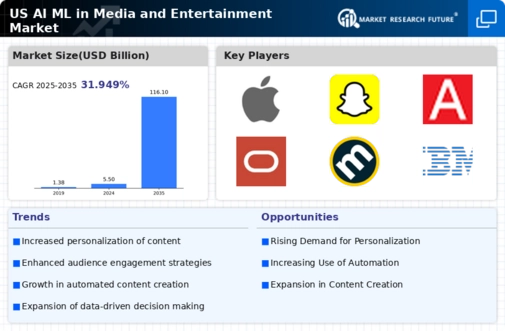Increased Focus on Data Analytics
The growing emphasis on data analytics is a crucial driver for the AI ML-in-Media-and-Entertainment market. Companies are increasingly utilizing AI and machine learning to analyze vast amounts of viewer data, enabling them to make informed decisions regarding content development and marketing strategies. In 2025, it is projected that the market for AI-driven analytics tools will reach $5 billion in the US alone. This surge is attributed to the need for businesses to understand audience preferences and trends better. By harnessing data analytics, media companies can tailor their offerings to meet consumer demands, thereby enhancing engagement and retention rates. The ability to predict viewer behavior through advanced analytics is likely to become a competitive advantage in the industry.
Rising Demand for Streaming Services
The increasing consumer preference for streaming services is a pivotal driver in the AI ML-in-Media-and-Entertainment market. As of 2025, the number of streaming subscribers in the US has surpassed 200 million, reflecting a shift from traditional cable to on-demand content. This transition necessitates advanced algorithms for content recommendation and user engagement, which are powered by AI and machine learning technologies. The competition among streaming platforms to provide personalized experiences is intensifying, leading to a surge in investments in AI-driven analytics. Companies are leveraging these technologies to analyze viewer behavior, optimize content delivery, and enhance user satisfaction. Consequently, the ai ml-in-media-and-entertainment market is poised for substantial growth as businesses strive to meet the evolving demands of consumers.
Regulatory Compliance and Ethical Standards
The evolving landscape of regulatory compliance and ethical standards is a significant driver in the AI ML-in-Media-and-Entertainment market. As AI technologies become more prevalent, there is an increasing need for companies to adhere to ethical guidelines and regulations regarding data usage and privacy. In 2025, it is anticipated that the US will implement stricter regulations governing AI applications in media, necessitating investments in compliance solutions. Companies are likely to adopt AI-driven tools to ensure adherence to these standards while maintaining operational efficiency. This focus on ethical AI implementation not only mitigates risks but also enhances brand reputation, as consumers are becoming more conscious of data privacy issues. Consequently, the ai ml-in-media-and-entertainment market is expected to evolve in response to these regulatory pressures.
Advancements in Content Creation Technologies
Technological innovations in content creation are significantly influencing the AI ML-in-Media-and-Entertainment market. The integration of AI and machine learning tools in video editing, animation, and special effects is revolutionizing the production process. For instance, AI-driven software can now automate complex tasks such as color correction and sound editing, reducing production time and costs. In 2025, it is estimated that AI technologies could decrease production costs by up to 30%, making high-quality content more accessible to creators. This democratization of content creation is fostering a diverse range of media offerings, thereby expanding the market. As more creators adopt these technologies, the demand for AI solutions in the media and entertainment sector is expected to rise, further propelling market growth.
Emergence of Interactive and Immersive Experiences
The rise of interactive and immersive experiences is reshaping the landscape of the AI ML-in-Media-and-Entertainment market. Technologies such as virtual reality (VR) and augmented reality (AR) are increasingly being integrated into media offerings, providing audiences with engaging and participatory content. As of 2025, the VR and AR market in the US is expected to exceed $30 billion, driven by advancements in AI that enhance user interaction. These technologies rely heavily on machine learning algorithms to create realistic environments and responsive narratives. The demand for immersive experiences is prompting media companies to invest in AI solutions that can deliver personalized and adaptive content, thereby attracting a broader audience and fostering deeper connections with viewers.
























Leave a Comment